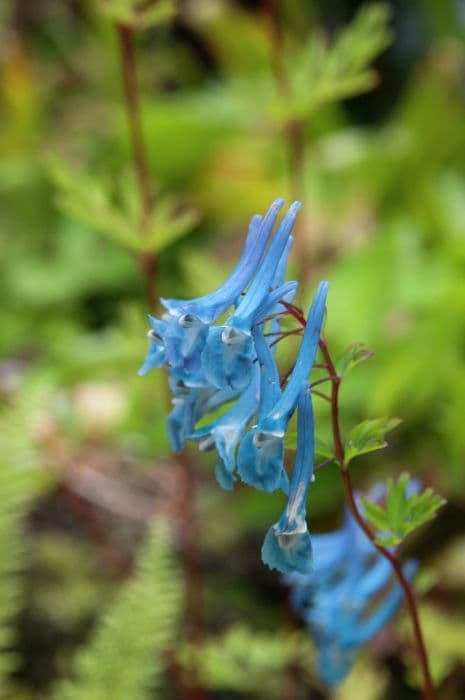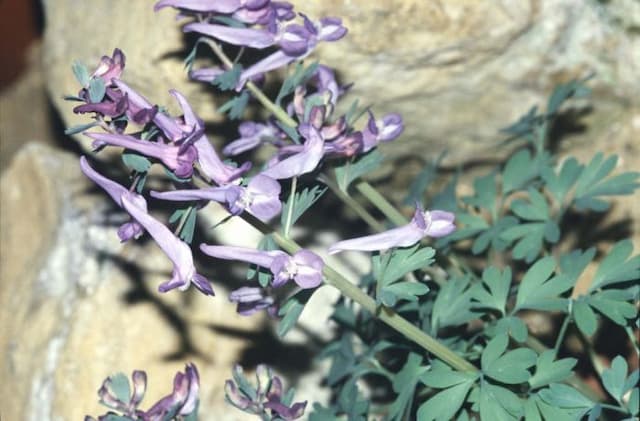California Poppy Eschscholzia caespitosa

ABOUT
Eschscholzia caespitosa, commonly known as the tufted poppy, is a herbaceous flowering plant that exhibits distinct characteristics. This perennial species often sports a neat rosette of finely divided, bluish-green leaves that provide a delicate and feathery backdrop for its flowers. The leaves themselves are lobed and dissected, looking almost fern-like in their intricacy. The tufted poppy is particularly admired for its brilliant flowers which are typically a vibrant orange or yellow color. The flowers comprise four petals that form a cup or bowl shape, emanating a sense of simple elegance. These petals can sometimes have shades or streaks that are slightly paler in color, adding to their charm. The blooms are solitary on long, slender stalks that emerge from the basal rosette. At the center of each flower, there is a group of numerous stamens which are characteristically prominent and are bunched together, giving a burst of additional texture and color contrast against the petals. The stamens surround a singular pistil that stands erect amidst them. After flowering, the tufted poppy produces slender seed pods that are elongated and erect. The pods eventually split open to disperse small, dark seeds which can readily self-sow in suitable conditions. Gracing the landscape where it grows, the tufted poppy brings a splash of warm color that can be considered a hallmark of its presence. The overall appearance of the tufted poppy is delicate yet lively, creating a striking visual when it blooms en masse.
About this plant
 Names
NamesFamily
Papaveraceae
Synonyms
Tufted Poppy, Foothill Poppy, Collarless California Poppy, Dwarf Poppy
Common names
Eschscholzia caespitosa.
 Toxicity
ToxicityTo humans
The plant known as Eschscholzia caespitosa is more commonly referred to as the tufted poppy. Generally, the tufted poppy is not considered toxic to humans. There are no well-documented cases of poisoning from this plant, and it is not known to contain any significant toxins that would cause harm if ingested. Therefore, no symptoms of poisoning or possible consequences of ingesting any part of the tufted poppy are expected under normal circumstances.
To pets
Similar to its effects on humans, the tufted poppy (Eschscholzia caespitosa) is not widely recognized as toxic to pets. There is no substantial evidence to suggest that this plant poses a health risk if ingested by animals such as dogs or cats. Thus, no specific symptoms of poisoning or potential health consequences are typically associated with the ingestion of any part of the tufted poppy by pets. However, it is always prudent to exercise caution and prevent pets from consuming plants, as individual animals may have sensitivities or allergic reactions.
 Characteristics
CharacteristicsLife cycle
Annuals
Foliage type
Deciduous
Color of leaves
Green
Flower color
Yellow
Height
6 inches (15 cm)
Spread
6 inches (15 cm)
Plant type
Herb
Hardiness zones
6
Native area
California
Benefits
 General Benefits
General Benefits- Low Maintenance: Eschscholzia caespitosa, commonly known as Tufted Poppy, requires minimal care once established, making it an ideal choice for gardeners of all levels.
- Drought Tolerance: Being native to California, Tufted Poppy is well-adapted to dry conditions and can thrive with little water, conserving this precious resource.
- Erosion Control: Its root system helps stabilize soil, reducing erosion on slopes and disturbed areas.
- Attracts Pollinators: The bright flowers of the Tufted Poppy attract bees, butterflies, and other beneficial insects to the garden, supporting local ecosystems.
- Aesthetic Appeal: With its vibrant yellow to orange flowers, the Tufted Poppy adds color and beauty to landscapes and ornamental gardens.
- Wildlife Habitat: Provides food and shelter for various species of insects, thus supporting biodiversity.
- Easy to Propagate: Tufted Poppy seeds are easy to collect and sow, making it simple to propagate and spread the plant in suitable areas.
 Medical Properties
Medical Properties Air-purifying Qualities
Air-purifying QualitiesThis plant is not specifically known for air purifying qualities.
 Other Uses
Other Uses- Floral Dye: The bright flowers of Eschscholzia caespitosa, commonly known as tufted poppy, can be used to obtain a yellow to orange dye for textiles.
- Photography: The vibrant display of the tufted poppy is a favorite subject for photographers, especially when capturing the essence of spring meadows.
- Garden Thematic Design: Due to its striking color, tufted poppy can be incorporated into color-themed garden designs, such as a 'sunset' or 'fire' garden concept.
- Artistic Inspiration: Artists may use the tufted poppy as a source of inspiration for paintings, drawings, and other forms of visual art.
- Educational Use: Botany educators may use the tufted poppy to teach students about plant biology, pollination, and the ecology of wildflowers.
- Petal Confetti: Dried petals of the tufted poppy can be used as a natural and biodegradable confetti for celebrations.
- Culinary Decoration: While not a common food item, the petals of the tufted poppy can be used to add a splash of color to salads and desserts as an edible decoration.
- Botanical Illustration: The tufted poppy is often included in botanical illustrations and field guides due to its distinct appearance and regional significance.
- Erosion Control: The tufted poppy can be planted on hillsides and in areas with loose soil to help prevent erosion thanks to its root system.
- Nature Crafts: The dried seed pods and flowers of the tufted poppy can be incorporated into nature crafts and decorations, such as wreaths and dried flower arrangements.
Interesting Facts
 Feng Shui
Feng ShuiThe California poppy is not used in Feng Shui practice.
 Zodiac Sign Compitability
Zodiac Sign CompitabilityThe California poppy is not used in astrology practice.
 Plant Symbolism
Plant Symbolism- Resilience: Eschscholzia caespitosa, commonly known as the tufted poppy, often symbolizes resilience because it can thrive in challenging conditions, including poor soils and drought.
- Beauty and Simplicity: The tufted poppy's simple yet vibrant flowers are a symbol of natural beauty and an appreciation for the uncomplicated aspects of life.
- Healing: Historically, different parts of the poppy plant have been used for medicinal purposes, which makes it symbolize healing and soothing of ailments.
- Remembrance: While typically associated with the red poppy, the notion of remembrance can extend to poppies in general as they are often used to commemorate soldiers and significant events.
 Water
WaterTo water the California Poppy, the plant's requirements are rather low, needing minimal water once established. During the growing season, watering once a week with about 1 inch of water is sufficient to keep them healthy. The method of watering should be direct to the root area to avoid wetting the foliage. It's important to allow the soil to dry out between waterings as California Poppies are drought-tolerant and excessive moisture can lead to root rot. In general, aim to provide around 0.5 gallons per square foot per month during the hot, dry months.
 Light
LightCalifornia Poppies prefer full sun conditions and thrive with a minimum of 6 to 8 hours of direct sunlight daily. The best spot for these plants is an open area where they are exposed to the full sun throughout the day without being shaded by larger plants or structures. If planted in too much shade, their blooming may be significantly reduced and their stems may become leggy.
 Temperature
TemperatureCalifornia Poppies are hardy in a range of temperatures, withstanding minimum temperatures down to 20°F and maximum temperatures well into the 100s°F. However, they grow best in temperatures between 50°F and 85°F. Extreme cold or heat may reduce blooming and stem growth.
 Pruning
PruningPruning the California Poppy is not generally necessary but deadheading spent blooms can encourage further flowering. Occasional thinning may be beneficial to improve air circulation, which can be done in late winter or early spring. These plants can also self-seed, so if you wish to control spreading, remove spent flowers before they set seed.
 Cleaning
CleaningAs needed
 Soil
SoilTufted Poppy thrives in well-draining sandy or loamy soil with a pH of 6.0 to 7.5. A mix of two parts sand, one part loam, and mature compost is ideal, ensuring good drainage while providing essential nutrients.
 Repotting
RepottingTufted Poppies are not generally repotted as they are annuals; however, if started in containers, they should be transplanted once to their final outdoor location when seedlings are established.
 Humidity & Misting
Humidity & MistingTufted Poppy prefers a dry to average humidity environment and does not require any special humidity adjustments when grown in its suitable outdoor habitat.
 Suitable locations
Suitable locationsIndoor
Ensure bright light and well-draining soil for Tufted Poppy.
Outdoor
Plant in full sun, well-draining soil, and space adequately.
Hardiness zone
6-10 USDA
 Life cycle
Life cycleEschscholzia caespitosa, commonly known as foothill poppy or tufted poppy, begins its life cycle as a seed, which requires a period of winter chill to break dormancy. Upon encountering favorable conditions in spring, the seed germinates, and the plant starts its growth as a small rosette of leaves close to the ground. The rosette stage allows the plant to store energy before bolting, where the stem elongates, and the plant prepares to flower. The flowering stage usually occurs in late spring to early summer, showcasing bright yellow blooms that attract pollinators for sexual reproduction. After pollination, the plant produces slender seed pods that dry and release seeds back into the soil, completing the reproductive cycle. The foothill poppy is an annual species, meaning it completes its entire life cycle within a single growing season and relies on seed production for the next generation's growth.
 Propogation
PropogationPropogation time
Spring
Eschscholzia caespitosa, commonly known as the tufted poppy, is usually propagated through seeds as this method is straightforward and effective for this species. The best time to sow tufted poppy seeds is in the fall, so they may naturally stratify during the winter months. The cold period helps to break the seed's dormancy, leading to better germination in the spring. You can simply scatter the seeds onto a well-draining soil mix and lightly cover them with soil, no more than 1/16th of an inch deep (approximately 1.6 mm). Keeping the soil moist but not waterlogged is crucial for germination, which typically takes place when the temperature is consistently warm, around 60 to 70 degrees Fahrenheit (15.6 to 21.1 degrees Celsius). It is important to avoid overwatering, as tufted poppy seeds may rot in soggy soil. Once the seedlings have developed their first set of true leaves, they can be thinned out to prevent overcrowding.









